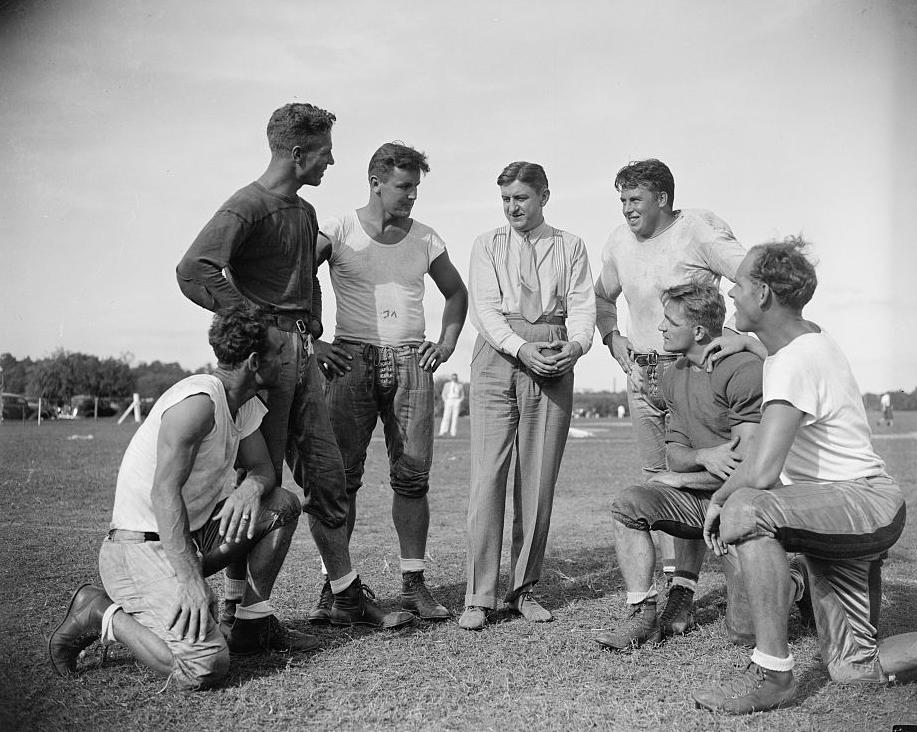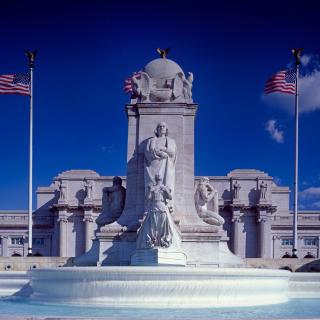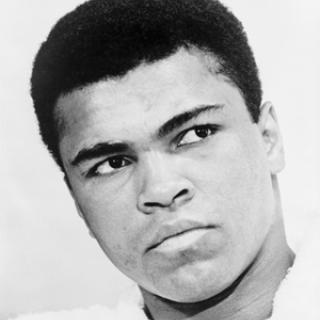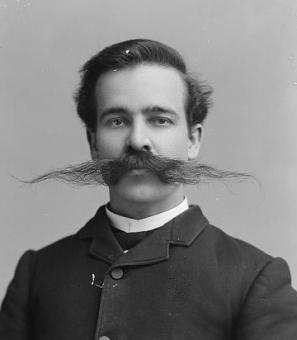"The Whitest Huddle of Any Team in the League"
By 1952, every team in the National Football League had African-American players... except one. Washington Redskins (now Commanders) team founder and owner George Preston Marshall steadfastly refused to integrate and dragged his feet for ten more years until his hand was forced.
At the time, Washington was one of the worst teams in the NFL (in terms of success on the field, not only its racial stance), in large part because of their owner’s refusal to consider non-white players.[1] While Marshall claimed that he simply drafted based on merit, and no black player had yet met his criteria,[2] most observers saw through the rhetoric. Reports from historically black Howard University indicated that “every other team in the NFL” showed high interest in their football roster, and “[o]nly the Redskins ...showed no interest in Howard’s players.”[3] The team’s whites-only policy provided extra motivation for African-American players on other teams. Chicago Cardinals running back Ollie Matson claimed he was “speaking for all the Negro players in the league” when he said, "We try a little harder when we play the Washington team."[3]
Marshall’s stubborn prejudice combined with his team’s abysmal record regularly made him an object of ridicule in sports columns. Washington Post sportswriter Shirley Povich was a frequent critic of Marshall and his segregationist views, writing that “[t]he Redskins end zone has frequently been integrated by Negro players, but never their lineup,”[4] while the Baltimore Afro-American’s acclaimed sports editor Sam Lacy suggested their name should be changed to the “Washington Confederates” or the “Washington Lily-Whites.”[5] Lacy also called for a boycott of Washington games, saying that black fans should not support a man who was so racially prejudiced.
All this, and Marshall refused to budge. On top of his personal prejudice, he had developed an established fanbase marketing his squad as “the South’s team”; until the Dallas Cowboys entered the league in 1960, Washington was the southernmost NFL franchise. Marshall had worked hard to stamp this Southern image onto his team: Washington games were opened with “Hail to The Redskins,” “Dixie,” and the national anthem — in that order.[6] Fans capped off the fight song with rebel yells and halftime shows sometimes featured performers in blackface. On the back of this image, Marshall had built a Southern radio and TV empire, with the most television coverage of any pro football team.[7] In his mind, hiring non-white players would jeopardize the team’s popularity with white Southern fans and their wallets.[8]
By the late 1950s, however, Washington, D.C. was a majority black city, and its citizens were increasingly vocal about wanting a football team that would represent them. In 1957, the NAACP picketed the NFL owners’ meeting,[9] and some black fans began taking Lacy’s advice and boycotting games. In an era of increasing civil rights visibility, the nation’s eye was increasingly drawn to these protests.
During this time, however, Marshall was ignoring the protests and had his eye, instead, on expanding his empire. Wanting to get out of aging Griffith Stadium (and out of paying rent to the owners, the Washington Senators Baseball Club), Marshall embarked on an ambitious project — a huge new stadium, to further accommodate ever-larger numbers of fans. He convinced the U.S. Congress to authorize funding for a new $22.5 million arena ($177 million today), coined D.C. Stadium, on the banks of the Anacostia River, to be leased by the Senators and Marshall’s Redskins. (In 1968, it was renamed R.F.K. Memorial Stadium.) Marshall was ecstatic. As he told the press, moving his team into the new 50,000-seat stadium was “the apex of my whole sports career. It is the biggest milestone of my life...Not a single bench in the park — even armchairs in the bleachers. Not a post to obstruct the view. Sixty percent of the seats under cover. Parking for 12,000. It will be the last word. I’ve never felt so exhilarated about anything.”[10]
But it wasn’t that simple. D.C. Stadium was built on government-owned land, with government funding providing many of those millions upon millions of dollars. So, in signing a lease to play there, Marshall had to comply with Department of the Interior policies, which included a ban on racial discrimination in hiring.[11] On this basis, Secretary of the Interior Stewart Udall threatened to bar the team from the stadium if Marshall did not hire a black player for the 1961 season. This resulted in a widely publicized standoff, with Marshall claiming that Udall had no authority to keep him out of his stadium, and Udall asserting that Marshall would face the consequences if he kept up his stubbornness.
As Marshall managed to get Udall to extend the deadline for integration to 1962, allowing him to field an all-white team during 1961, protests by civil rights activists reached an all-time high. At various points throughout the 1961 season, the newly opened D.C. Stadium was the site of protests led by Rev. Franklin E. Jackson and the Congress for Racial Equality (CORE), sometimes attended by hundreds of people.[12] Picket lines also appeared at road games in San Francisco and Los Angeles. Increasing numbers of black fans boycotted the team, and President Kennedy refused an invitation to attend the opening game of the 1961 season.[13]
Incredibly, despite all this, as the deadline for integration approached, Marshall became increasingly evasive, saying that the government had no power to keep him out of the stadium. Faced with public opinion gone sour, the scorn of the press, and further threats from Udall, however, Marshall backed down. Threatening to take Marshall’s baby away finally outweighed his staunchly racist beliefs.
Under pressure, Marshall reluctantly selected three African-American players in the 1962 draft, grumbling, “You can’t tell what will happen under the guise of liberalism.”[14] With the top pick, the team snagged highly-sought-after running back Ernie Davis from Syracuse University.[15] As Shirley Povich snarked, the team was “in excellent No. 1 draft position because their record is unsullied by a victory.”[16] (Then, as now, the team with the worst record from the previous season got the first pick.) In later rounds, the Redskins selected two other black players, guard John Nisby and fullback Ron Hatcher.
Marshall promptly traded Davis to Cleveland for running back Bobby Mitchell, another African-American player. It was a round-about process, but the NFL was finally fully integrated. With this news, the Baltimore Afro-American ended its fifteen-year press boycott of Washington games, and Lacy interviewed Marshall about the draft, expressing tentative approval. When Marshall, after shaking Lacy’s hand, smilingly remarked that it had “been a long time,” Lacy replied, “I had no reason to see you before today.”[17]
Marshall, of course, was dragged into integration kicking and screaming. Among other things, he refused to be photographed with Hatcher, the first black player Washington officially signed, at the signing ceremony, claiming that he did not want to “exploit” the situation — which would certainly be a first for a showman of his caliber. Furthermore, Marshall never admitted that Udall or anyone had had any influence on his decision, maintaining that he only integrated because he wanted to.[18][19]
Mitchell shrugged off his role as an “integrator,” but, as he related years later, “It was a real traumatic thing to come from a winning football team, great surroundings, where your coach and management looked after you, to come here, where you were being called [racial slurs] every day, and every time you run down the field, some guy’s throwing something at you… And we’re talking about the ’60s. To have all that on your shoulders and try to perform, you had both white and black who couldn’t stand for you to make a mistake.”[20] Despite Mitchell’s hostile reception by many whites, in 1962 he led the Redskins to their best season in years, silencing his critics.[21] He would finish his career in Washington and be inducted into the Pro Football Hall of Fame in 1983.
More Information
- More on the construction of D.C. Stadium: http://blogs.weta.org/boundarystones/2012/11/21/dc-dome
- For more detail on the government’s role in integrating the team, and the whole process of integration in general, this book is a very interesting read: Thomas G. Smith, Showdown: JFK and the Integration of the Washington Redskins, (Boston, MA: Beacon Press, 2011). I also sourced it heavily over the course of this article.
- Charles K. Ross, Outside the Lines: African Americans and the Integration of the National Football League, (New York: NYU Press, 2001).
- The official team history, which makes no mention of any of these events except for Bobby Mitchell’s signing: http://www.redskins.com/team/history/history-by-decades.html
Footnotes
- ^ The team had racked up one win per season during their final two years before integration (both of them, incidentally, against the Dallas Cowboys.) Their season records, in case you’re interested, are here and here.
- ^ To which sportswriter Leon Smith snarked, “Year after year, [he] explains that there just aren’t any Negro football players good enough to play on his squad, which annually finishes at the bottom of its league.” Leon Smith, “Smith’s Griddle…,” Los Angeles Tribune, January 1, 1960.
- a, b Shirley Povich, “This Morning…,” Washington Post, April 27, 1961.
- ^ Thomas G. Smith, Showdown: JFK and the Integration of the Washington Redskins, (Boston, MA: Beacon Press, 2011), 168. Other choice quotes: “[Marshall is] getting more publicity than any loser since Robert E. Lee.” — Povich. (Ibid., 121); and, as referenced in the title, “[Quarterback Norm] Snead faces the blackest future and the whitest huddle of any team in the league.” — Ted Maule, Sports Illustrated. (Ibid., 141)
- ^ Ibid., 121. (Confidential to Dan Snyder: These are maybe not your best options.)
- ^ And he doubled down as criticism mounted. In 1959, he changed the fight song’s lyrics from “Fight for old D.C.” to “Fight for old Dixie.” Ibid., 120-1.
- ^ Washington was the first NFL team to have all of their games televised.
- ^ He had argued against integrating the NFL for decades, and was most likely the one responsible for brokering the “gentleman’s agreement” that barred black players from the League in the first place, in 1933. Beforehand, there had been a handful of black players in the NFL in every season since its inception. In that same year, incidentally, he also changed his team’s name from the “Braves” to the “Redskins,” both because he wanted a stronger connection with Fenway Park co-inhabitants the Boston Red Sox, and because he lacked any concept of subtlety. (Interestingly enough, the Red Sox were also the last team in their league to integrate.)
- ^ Thomas Smith, Showdown, 126.
- ^ Thomas Smith, Showdown, 202-3.
- ^ Ibid., 150.
- ^ “Redskins Face Negro Issue On Picket Line,” Washington Post, September 30, 1961.
- ^ Thomas Smith, Showdown, 166-7.
- ^ Thomas Smith, Showdown, 158.
- ^ Sadly, Davis was diagnosed with leukemia in 1962, and never played a professional game before his untimely death in 1963.
- ^ Shirley Povich, “This Morning...,” Washington Post, November 17, 1961. (This comment came before their heroic triumph over the 4-9 Cowboys in the final game of the season.)
- ^ Thomas Smith, Showdown, 178.
- ^ Ibid., 176.
- ^ In a later interview with Frank Boggs of the Dallas Times-Herald: “Q — Once, you were picketed because of not playing Negroes...Did that picketing ever bother you? A — No.” [end of response] Thomas Smith, Showdown, 186.
- ^ Thomas G. Smith, "1962: The Year That Changed the Redskins," Washingtonian, 10 Oct 2011. http://www.washingtonian.com/blogs/capitalcomment/1962-the-year-that-changed-the-redskins.php
- ^ The team started the season with a six-game undefeated streak before running out of steam and winding up in 4th place in the NFL East. Still, it’s better than last.






![Sketch of the mythical fuan by Pearson Scott Foresman. [Source: Wikipedia]](/sites/default/files/styles/crop_320x320/public/2023-10/Goatman_Wikipedia_Faun_2_%28PSF%29.png?h=64a074ff&itok=C9Qh-PE1)












